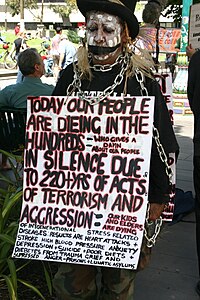IND/What are Human Rights?
While the idea of rights and justice for oppressed groups of people has a very long history, since the end of World War II the United Nations (UN) has been the global organisation which has developed statements of human rights and investigated breaches of human rights throughout the world.
The UN has a number of different ‘instruments’ which outline different types of human rights. These include, for example, the Convention for the Elimination of All Forms of Racial Discrimination which sets out the human right to live free from racial discrimination, the International Covenant on Economic, Social and Cultural Rights, which covers human rights regarding economic life or the right to live a distinct cultural life, and the Convention on the Elimination of all Forms of Discrimination against Women which explains the human rights of women. Many governments around the world (but not all of them) become signatories to these instruments, that is, they agree to uphold the human rights set out by the UN for all of the people who live in their country. Governments also pass domestic laws to protect these rights, for example, the Racial Discrimination Act (1975) was passed in Australia to protect Australians from racial discrimination.
Once a country has become a signatory to these human rights instruments, the UN will investigate their progress towards protecting those human rights on a regular basis. Countries are under no legal obligation to uphold the rights in the instruments, but the UN carries significant moral weight and violating human rights can damage a country’s international reputation.
Indigenous organisations and individual Indigenous people, like all other organisations and individuals, can appeal directly to the UN about violations of their human rights.
Indigenous Australians have used the UN human rights system to bring international attention to violations of their human rights, attempting to remedy these violations. As Sarah Pritchard, an international human rights lawyer, has written, “Indigenous peoples’ organisations have been extremely effective in their efforts to secure recognition by the international legal system of the rights which arise from their specific historical and contemporary experiences” (1998, p. 3).
This continues an older tradition of Indigenous people petitioning people both in Australia and overseas to resist violations of Aboriginal rights. The first of these petitions was sent in 1847 to Queen Victoria from Tasmanian Aboriginal people. The petition draws attention to living conditions on Flinders Island where Aboriginal people had been removed to after the “Black War” between Aboriginal people and white settlers in Tasmania (Thompson, 2010, pp. 109-111). You can read the words of that first petition in the Thompson article below.
We will return to issues of human rights in the final week of the subject, but keep the provisions of The Universal Declaration of Human Rights (included in the required reading below) in mind as we examine the various struggles for rights which Indigenous Australians have engaged in over the 20th century.
